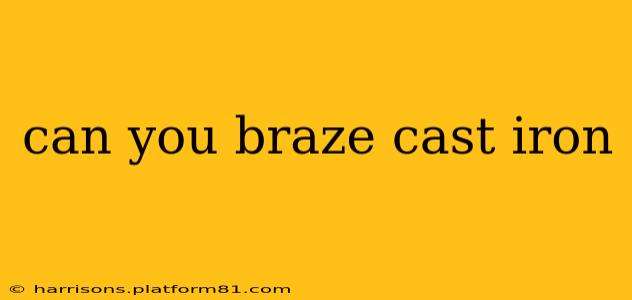Can You Braze Cast Iron? A Comprehensive Guide
Cast iron, known for its durability and heat retention, is a popular material for cookware, engine blocks, and various other applications. But can you braze it? The short answer is: yes, but with significant caveats. Brazing cast iron is possible, but it's more challenging than brazing other metals and requires specific techniques and considerations. This guide will delve into the complexities, addressing common questions and concerns.
What is Brazing?
Before we discuss brazing cast iron, let's clarify the process. Brazing is a joining process that uses a filler metal with a lower melting point than the base metals being joined. The filler metal flows into the joint by capillary action, creating a strong bond. Unlike welding, brazing doesn't melt the base metals.
Why Brazing Cast Iron is Difficult
Cast iron's inherent porosity and its susceptibility to cracking during heating pose significant challenges to brazing. The high carbon content can also interfere with the brazing process. Improper techniques can lead to a weak joint or even damage the cast iron itself.
What Type of Brazing is Suitable for Cast Iron?
While various brazing methods exist, silver brazing or high-temperature brazing is generally preferred for cast iron due to the higher temperatures required to achieve proper capillary action and penetration into the cast iron's porous structure. However, even with silver brazing, success isn't guaranteed.
How to Braze Cast Iron (If You Must)
Brazing cast iron is a specialized task best left to experienced metalworkers with the right equipment. If you're determined to attempt it, follow these steps cautiously:
-
Thorough Cleaning: The surfaces to be brazed must be meticulously cleaned. Remove all rust, scale, grease, and any other contaminants. Use a wire brush, grinder, or chemical cleaning agents as necessary.
-
Proper Flux: Using the correct flux is crucial. A high-quality brazing flux designed for cast iron will help to remove oxides and facilitate the flow of the filler metal.
-
Preheating: Preheating the cast iron to a specific temperature is essential to reduce the thermal shock and minimize the risk of cracking. The exact temperature will depend on the specific alloy and brazing materials.
-
Controlled Heating: A controlled heat source, such as a torch with precise flame adjustment, is needed. Even heating is critical to prevent warping or cracking.
-
Filler Metal Application: The brazing filler metal should be applied carefully to the joint, ensuring complete penetration.
-
Cooling: Allow the brazed joint to cool slowly to further minimize the risk of cracking.
What are the Alternatives to Brazing Cast Iron?
Considering the challenges associated with brazing cast iron, exploring alternative joining methods might be more practical and reliable. These include:
- Welding: Welding offers a stronger and more durable joint than brazing, but it requires specialized skills and equipment.
- Bolting/Fastening: For many applications, simply bolting or fastening the components together is a simpler and safer approach.
- Epoxy Adhesives: For non-structural applications, strong epoxy adhesives can provide a suitable alternative.
Is it Worth Brazing Cast Iron?
Given the difficulties and potential for failure, brazing cast iron is often not the most practical or cost-effective approach. The chances of success depend heavily on expertise and proper equipment. Weigh the risks carefully and consider alternatives before attempting to braze cast iron. For most applications, other methods offer a more reliable and safer solution.
What are the common problems encountered when brazing cast iron?
Common problems include cracking of the cast iron due to thermal shock, insufficient filler metal penetration due to porosity, and the formation of weak joints due to improper cleaning or flux application.
What type of filler metal should be used for brazing cast iron?
High-temperature brazing filler metals like those containing silver or nickel are generally recommended due to their higher melting points and better flow characteristics for cast iron. The specific alloy should be chosen based on the application's requirements.
This information is for guidance only and does not constitute professional advice. Always exercise caution when working with heat and potentially hazardous materials. If you're unsure about any aspect of brazing cast iron, it's best to seek the assistance of a qualified professional.
